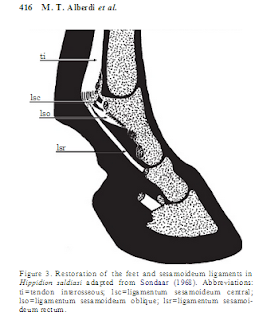In 1699, a French explorer who sailed along the coast of South America, Gouin de Beauchesne, reported a strange discovery at Puerto Deseado in what is now Santa Cruz province, Argentina.
Mariners used to stop at that point since it has a fresh water spring - hence its name "Spring Bay". Finding water is quite infrequent along the Patagonian coast, so it was a well known place.
His men disembarqued and explored the surroundings. They found a skeleton of a horse and the animal's hoofs were so strange that they removed a leg and took it back on board with them as a curio.
Beauchesne kept it and later showed it to some "Spaniards who regularly trade horses in Chile, who told [him] that that horse had fed in a sandy region due to the bulge it had on its hoof, which caused it to not go far from where [they] found it." [1]
What strange deformity did the animal have on its hoofs? Or... were its hoofs normal and those of a pre-hispanic native American horse (supposedly extinct at the time)? By the way, do these horses' hoofs differ from those of modern Eurasian ones?
I have written about Hippidions in a post back in 2009 (Extant Prehispanic Horses?), but Goin de Beauchesne's report could be additional proof of their survival until recently.
Sandy terrain hoofs
Wild horses tend to have short heels (which are more comfortable=, the third phalanx and the sole are parallel to the ground. The "white line" has a stronger positition when resting than the third phalanx due to the small angles of the hoof. This configuration bends the leg and cushions impact when the horse trots. See the image below: [2]
But what were the hoofs of a Hippidion (the horse, native to America, that is believed to have become extinct just a few millennia before the arrival of European horses (after 1492 AD) like?
Below is the image of a Hippidion hoof (from [3]), it looks quite similar to a wild horse's hoof:
Of course since hippidion was a "wild" horse it is likely that its hoofs, like those of modern wild horses, adopted a characteristic shape due to lack of horse shoes and the rugged Patagonian terrain.
On the other hand the horse remains may have surprised the sailors because of its vestigial phalanxes, which are not so noticeable in modern horses.
It is a pity that there is no drawing or sketch of this horse's leg
Sources
[1] Relation du voyague du Sr. de Beuchesne au Chili dans la du sud de l'Amerique... Manuscript Paris Vicennes library.
[2] www.alexbrollo.com, El Casco.
[3] Maria T. Alberdi, Laura Miotti and Jose L. Prado. Hippidion saldiasi Roth, 1899 (Equidae, Perissodactyla), at thePiedra Museo Site (Santa Cruz, Argentina): Its Implication forthe Regional Economy and Environmental Reconstruction. Journal of Archaeological Science (2001)28, 411–419doi:10.1006/jasc.2000.0647
Patagonian Monsters - Cryptozoology, Myths & legends in Patagonia Copyright 2009-2014 by Austin Whittall ©


















No comments:
Post a Comment